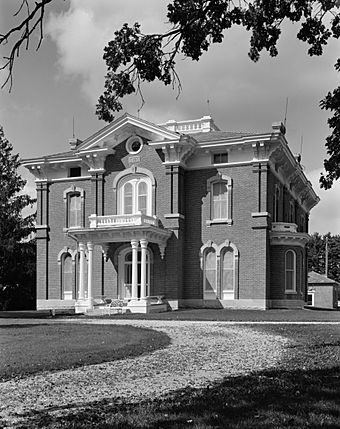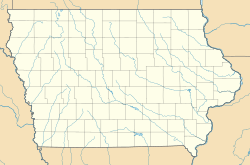Montauk (Clermont, Iowa) facts for kids
Quick facts for kids |
|
|
Montauk
|
|
 |
|
| Location | 1 mile northeast of Clermont on U.S. Route 18 |
|---|---|
| Built | 1874 |
| Architect | E. Townsend Mix |
| Architectural style | Italianate |
| NRHP reference No. | 73000725 |
| Added to NRHP | February 21, 1973 |
Montauk, also known as Montauk State Preserve, is a special historic house in Iowa. It is located northeast of Clermont, Iowa. This beautiful building was added to the National Register of Historic Places in 1973. This means it's an important place worth protecting.
Contents
Meet William Larrabee: Iowa's Former Governor
William Larrabee was a very important person in Iowa's history. He was born in Connecticut and became very successful. He made his money as a banker, a factory owner, and by owning a lot of land.
Larrabee's Political Journey
William Larrabee was a member of the Republican Party. He served for 18 years in the Iowa Senate, which is part of Iowa's government. After that, he became the Governor of Iowa for two terms. Even though he was one of the richest landowners in Iowa, he worked hard to make the government better for everyone.
Fighting for Fairness
During his time in politics, Larrabee led a big effort to control railroad companies. These companies were charging too much money and acting unfairly. His work helped create the Interstate Commerce Commission. This group helps make sure that businesses like railroads are fair to people. After his second term as governor, he retired to his home at Montauk. He was also a friend of President Theodore Roosevelt.
Montauk: A Historic Iowa Home
The Montauk house was built in 1874. William Larrabee's wife, Anna Matilda Appelman, wanted a house on a hill. She was worried about illnesses like malaria that were common near the Turkey River.
Design and Construction of Montauk
The house is a large, two-story mansion with 14 rooms. It was designed by Milwaukee architect E. Townsend Mix. The style of the house is called Italianate. The bricks used to build it were made right in Clermont. The stone came from a nearby quarry. The porches and the special "widow's walk" on the roof are made of wood. The house was named Montauk after the Montauk Point Light lighthouse. This was a way to honor Mrs. Larrabee's family, who were involved with the sea.
Life at Montauk Farm
Montauk was more than just a house; it was a busy working farm. It had many buildings, including a caretaker's house, a water tower, a well house, and a laundry. There was also a creamery, a workshop, a barn, and places to store corn. The farm had sheds, a vegetable garden, and an orchard. They raised many animals, including peacocks, turkeys, chickens, and cattle.
Art and Statues at Montauk
Inside the house, you can find many beautiful works of art. These include paintings by famous artists like Louise Élisabeth Vigée Le Brun and William Bradford. An Iowa artist named David John Cue painted portraits of the Larrabee family. Outside in the yard, there are four bronze statues. These statues show important military leaders: Generals Ulysses S. Grant, William Tecumseh Sherman, and Grenville M. Dodge, and Admiral David Farragut. William Larrabee asked artists George Edwin Bissell and J. Massey Rhind to create these statues.
Montauk Becomes a State Preserve
After William Larrabee passed away in 1912, the house stayed in his family. His daughter, Anna, was the last family member to live there. She took care of the house until she passed away in 1965. In 1967, the family opened the house to the public so others could visit. In 1976, the family gave the house, everything inside it, and 40 acres of land to the state of Iowa. Today, the State Historical Society of Iowa helps protect and preserve this important property. Montauk was officially named a state preserve in 1984.



